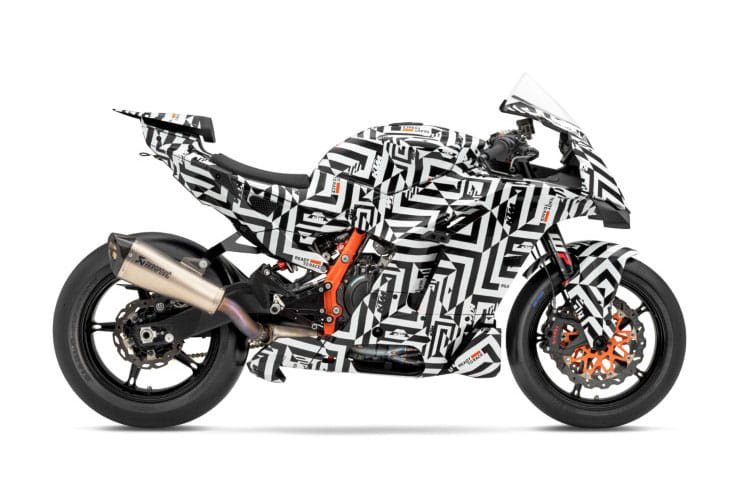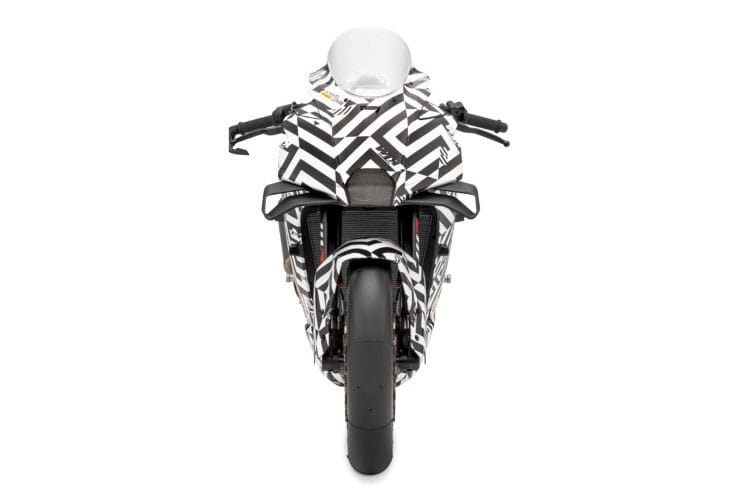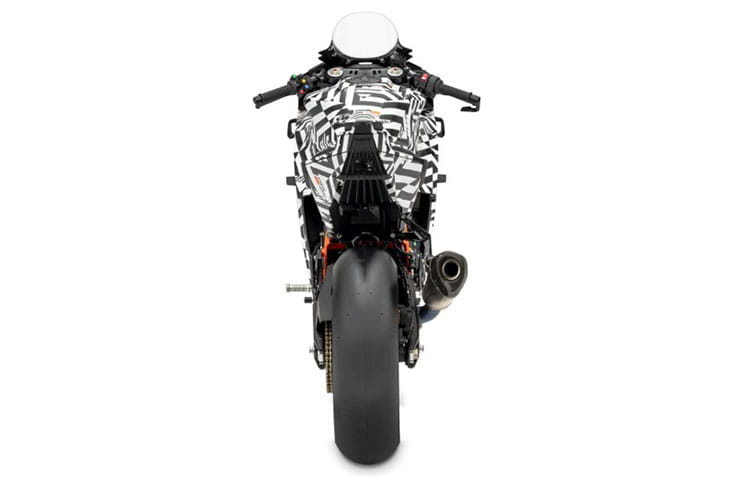Price: £TBA | Power: 126bhp | Weight: TBA | Overall BikeSocial Rating: TBA
KTM made a conscious decision to step away from the superbike market nearly a decade ago when it discontinued the 1190 RC8 R – citing that ever-more-powerful superbikes were increasing unsuited to real-world riders away from the confines of the racetrack. The new 990 RC R marks something of a return while aiming very clearly at the middleweight segment of the market rather than the superbike segment.
The bike won’t be launched in full until later this year, with production pencilled in for early 2025, but KTM has revealed near-finished prototypes that give a clear indication of the direction while hiding styling elements – most notably the headlights – behind a distraction camo wrap. Even at this stage, though, it’s clear that the 990 RC R will be an intriguing proposition for sports bike buyers in 2025.
Pros and Cons
- Finally, KTM returns to the sports bike market nearly a decade after the RC8R was dropped
- High-end suspension
- MotoGP-inspired styling will appeal to hardcore sports bike fans
- 126hp doesn’t seem a lot from 947cc
Review – In Detail
Price & PCP
For and against
Engine & Performance
Handling & Suspension (inc. weight & brakes)
Comfort & Economy
Equipment
Rivals
Verdict
Specification
KTM’s lead-in to the 990 RC R has been a couple of runs of limited-edition track-only bikes, the RC 8C. First unveiled in 2021 and with a second coming in 2023, those bikes were based on the Kramer GP2-R and built out-of-house by Kramer, with small production runs of 100 for the first-gen and 200 for the second model, each selling out instantly despite vastly expensive price tags - £30,999 for the first run, £34,999 for the second-gen.
While KTM has yet to announce a price for the new 990 RC R, it won’t be anywhere near that expensive. The firm’s head of global marketing, Riaan Neveling, said: “This bike offers power and prestige without the exorbitant price tag.”
How much will it cost? Well, it’s safe to say that with uprated suspension, full bodywork and more power than the 990 Duke that it’s based on, it will cost more than the Duke’s £12,999. But it’s also intended to be used in World Supersport racing under the ‘Next Generation’ ruleset, which places a price limit of €26,400 on the homologated street versions of the race bikes, including the manufacturer’s compulsory racing kit. That’s equivalent to £22,750, and without the racing kit the figure is sure to be substantially lower than that. Given that a Ducati Panigale V2, also aimed at the ‘Next Generation’ race class and making substantially more power in street form than the KTM can muster, is £17,195, we’d expect the 990 RC R to slide in at somewhere around £15k.
The 990 RC R’s power comes from essentially the same parallel twin engine that drives the current 990 Duke. New for 2024, it’s the second generation of ‘LC8c’ twin – carrying over the same general layout as the previous ‘890’ and ‘790’ versions but completely redesigned with new cases, cylinders and head as well as all-new internals.
With a 70.4mm stroke and 92.5mm bore, the total capacity actually measures 947cc, and while KTM is keeping its cards close to its chest at the moment it doesn’t seem that any major alterations have been made from the Duke-spec engine for the 990 RC R. Peak torque, which is largely defined by the engine’s capacity, is unchanged at 103Nm (76lb-ft), and power rises only slightly from the Duke’s 121.4hp (123PS/90.5kW) to 126hp (128PS/94kW). Peak revs also rise from the Duke’s 9,500rpm to 10,300rpm.
Chances are that at least some of that extra power comes courtesy of the Akrapovic exhaust seen on the prototype shown here, as despite some hand-finished elements at this stage it appears to be a street-legal system with a collector/catalyst mounted below the front edge of the swingarm. The system is near-identical to the exhaust that was seen on prototypes for the 990 Duke, too.
Like the Duke’s version of the engine, the RC R’s motor meets the latest Euro 5+ emissions rules, as required for street use, and we can be sure it will at least match the Duke in terms of riding modes (three for the Duke, with a fourth, optional, track mode that can be unlocked via software).
As with the engine, the essence of the 990 RC R’s chassis is ported across from the 990 Duke. That’s a huge departure from the RC 8C track bikes, which used their own, Kramer-made tubular steel chassis, but KTM has tweaked the Duke’s frame design for the new sports bike.
The most noticeable visual alteration is an extra bolt that’s fitted through each main frame tube just above the foot pegs. This is part of a redesigned rear suspension system, providing an upper mount for a linkage that runs back to a rocker mounted in the swingarm, the other end of which compresses the rear shock.
KTM also says the frame’s rigidity has been increased to improve feel and stability on track, and that the weight distribution is moved forward compared to the Duke. Surprisingly, though, the rake has been revised to 25 degrees, which is slightly more relaxed than the 24.2 degrees of the 990 Duke.
In terms of suspension, both ends come from WP – of course – and are fully-adjustable. The parts used on the prototype appear to be Apex Pro 7543 forks, similar to those used on the RC 8C, allied to a rear shock that looks like a cross between the Apex Pro 8750 and 7746.
The brakes are Brembos, although two different sets of calipers appear on the prototypes in KTM’s official pictures. The main, studio shots show Stylema calipers, and those are likely to be used on the production version. KTM’s prototypes are shown on Pirelli slicks, but the road bikes will come on Michelin rubber.
The bike’s weight has yet to be confirmed but given the 990 RC R’s close relationship to the 990 Duke it can’t be a million miles from the Duke’s 179kg (without fuel) mass.

KTM puts great stake in the ergonomics of the 990 RC R – which bodes well for riders when it comes to controlling the bike.
The firm says that it’s done lengthy experiments on the ‘six contact points on the tank’ to improve the rider experience both in corners and when tucking-in on the straights, making it comfortable and reducing the pressure on the rider’s hands that comes from the forward-hunched riding position.
The footpegs are adjustable over a wide range of positions, and that’s not just something for the prototype stage of the bike’s development as KTM confirms adjustability will be carried over to the production bikes. There’s no indication yet that there will be any provision for passengers, though.
The race-inspired bodywork has clearly been developed with the RC16 MotoGP bike as its template, with biplane front winglets and intriguing air guides at the front lower edges of the fairing. It also features a GP-style scoop under the belly, just ahead of the rear wheel, to pull air up before it hits the back tyre. Whether that aero will translate into road-going comfort or work only when you’re in a full-race crouch remains to be seen, though.
In terms of economy, we won’t know fuel efficiency figures until the bike has undergone type-approval, something that’s unlikely to happen until nearer its early-2025 production target, but the close relationship to the 990 Duke means that the consumption isn’t likely to be too far from that bike’s claimed 60.1mpg.

KTM is usually near the front of the pack when it comes to electronic equipment on its bikes and while the company hasn’t yet confirmed full details of the 990 RC R’s package it’s sure to tick most of the right boxes.
As well as multiple riding modes, like the 990 Duke, it’s sure to have an up/down quickshifter, cornering ABS and cornering traction control.
The prototypes seen here have an ECUMaster digital display, and KTM’s hope that the 990 RC R will be easily adapted to race form suggests that the production model may follow suit. Expect to see extensive options when it comes to datalogging and display formats.
As a machine intended to compete in Supersport racing – the prototypes will be making wildcard appearances in the European Supersport series this year before production even starts – it’s not hard to see the machines it will be competing against on the track. The same bikes will also provide its toughest competition on the road, so buyers will be comparing against:
Ducati Panigale V2 | Price: £17,195
Power/Torque: 155bhp/77lb-ft | Weight: 193kg (wet)
MV Agusta F3 800 RR | Price: £21,700
Power/Torque: 147bhp/65lb-ft | Weight: 199kg (wet)
Honda CBR600RR | Price: £10,499
Power/Torque: 119bhp/46.5lb-ft | Weight: 193kg (wet)
We’ll let you know when we’ve ridden it!
If you’d like to chat about this article or anything else biking related, join us and thousands of other riders at the Bennetts BikeSocial Facebook page.

|
New price
|
From £TBA
|
|
Capacity
|
947cc
|
|
Bore x Stroke
|
92.5mm x 70.4mm
|
|
Engine layout
|
Parallel twin
|
|
Engine details
|
8-valve, DOHC, parallel twin, liquid-cooled
|
|
Power
|
126bhp (94kW) @ 10,300rpm
|
|
Torque
|
76lb-ft (103Nm) @ TBA rpm
|
|
Transmission
|
6 speed
|
|
Average fuel consumption
|
TBA
|
|
Tank size
|
TBA
|
|
Max range to empty
|
TBA
|
|
Rider aids
|
Cornering ABS, Cornering traction control, multiple riding modes
|
|
Frame
|
Chrome molybdenum steel tube frame, engine as stressed member
|
|
Front suspension
|
WP Apex Pro forks
|
|
Front suspension adjustment
|
Fully adjustable
|
|
Rear suspension
|
WP Apex monoshock
|
|
Rear suspension adjustment
|
Fully adjustable
|
|
Front brake
|
2 x discs, Brembo 4-piston radial calipers
|
|
Rear brake
|
Disc, Brembo 2-piston caliper
|
|
Front wheel / tyre
|
190/60 R17 Michelin
|
|
Rear wheel / tyre
|
120/70 R17 Michelin
|
|
Dimensions (LxWxH)
|
TBA
|
|
Wheelbase
|
TBA
|
|
Seat height
|
TBA
|
|
Weight
|
TBA
|
|
Warranty
|
TBC
|
|
Servicing
|
TBC
|
|
MCIA Secured Rating
|
Not yet rated
|
|
Website
|
www.ktm.com
|
Looking for motorcycle insurance? Get a quote for this motorbike with Bennetts bike insurance

What is MCIA Secured?
MCIA Secured gives bike buyers the chance to see just how much work a manufacturer has put into making their new investment as resistant to theft as possible.
As we all know, the more security you use, the less chance there is of your bike being stolen. In fact, based on research by Bennetts, using a disc lock makes your machine three times less likely to be stolen, while heavy duty kit can make it less likely to be stolen than a car. For reviews of the best security products, click here.
MCIA Secured gives motorcycles a rating out of five stars (three stars for bikes of 125cc or less), based on the following being fitted to a new bike as standard:
- A steering lock that meets the UNECE 62 standard
- An ignition immobiliser system
- A vehicle marking system
- An alarm system
- A vehicle tracking system with subscription
The higher the star rating, the better the security, so always ask your dealer what rating your bike has and compare it to other machines on your shortlist.














![Ducati Panigale V2 2020 [ Review ]](jpg/ducati%20panigale%20v2_0581472.jpg)









